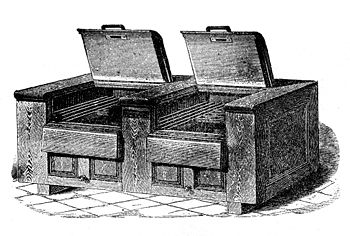Ice chest
The ice box , also known as a cool box or natural ice cabinet, is the simple forerunner of the more convenient, currentless ice cabinet . An ice box is a reservoir for keeping food and drinks cool with small amounts of ice. In Austrian, too, the ice chest was originally referred to as the object described here.
A simple cooling box consisted of a wooden box lined with zinc sheet, which in the summer had to be supplied with sticks made of natural ice several times a week by an ice cream man . There were refrigerated boxes both for household use and especially for taking with you on trips with large luggage.
The users of these cooling devices were confectioneries, delicatessen, poultry, game and fish stores, hotels and large restaurants.
Is the modern successor to this cooling box with the polystyrene umschäumte icebox or cooler bag, which with ice packs cool place with ice.
construction
"The ice box consists of a tightly crafted wooden box with a well-closing lid, under which there are various compartments with smaller, sloping lids. The lower part contains a sheet metal box to hold the ice. The bottom and the side walls are supported by a 5 cm of The sheet metal wall protruding from the surrounding wall is formed; the space is tightly filled with ash, wool or other poor heat conductors. Above the ice in the lower part there are perforated or rust-like shelves or wire grids to place the food, etc. on it. On the bottom there is a with Valve provided with a pipe to drain the melt water. "(Nöthling, 1896, p. 129)
These thickly clad, doorless boxes are provided with double lids, in the lower part of which the ice is placed to keep the food fresh for up to 14 days.
Ice Conservator
Also known as the frozen device, the items are very solidly built so that they can hold frozen food for up to 24 hours. For this purpose, the ice was mixed with salt and filled into the ice container, with about half of the ice and half of the salt remaining after 24 hours. The container, which is encased in strong iron bands, holds the frozen food in its interior in porcelain jars with metal lids. Particularly thick-walled models, which were only used to hold raw ice cream, were able to prevent the ice cream from melting for weeks, for example in pastry shops.
Food Conservator
A food conservator is particularly suitable for cooling raw meat, food, bottles etc. and only needs to be filled with new ice every 5 days. Plates and plates can be placed on grids.
The ice box for butter separates two compartments from each other by the vertical, centrally arranged ice container. The two butter churns come to rest on wooden grids.
Manufacturer around 1896
In 1896, Ernst Nöthling classified the following as better known manufacturers:
- Theodor Weigele, Berlin S., Alte Jakobstrasse 50
- Zeppernick & Harz, Berlin SW., Gitschiner Strasse 108
- Schmidt & Keerl in Kassel
- Werner & Bardach, Düsseldorf, Bilker Allee 49
- CF Kirchhof's Sons, Vienna IV, Schaumburgergasse 8
See also
In a small household, an ice cream pot can function as an ice box much cheaper.
literature
- Ernst Nöthling: The ice cellar. Ice houses and ice boxes their construction and use. For construction technicians, brewery owners, farmers, butchers, confectioners, innkeepers, etc. 5th edition. Bernhard Friedrich Voigt Verlag, Weimar 1896.



